The Future of SEO & AI: Adapting to Intentional Search Experiences
Published by Spinutech on August 28, 2024

We’ve heard what’s being said about SEO.
That it is more like “Answer Engine Optimization” than Search Engine Optimization.
Here’s the thing: We disagree.
Answer Engine Optimization is a narrow focus that prioritizes Generative AI, but Featured Snippets and smart results like People Also Ask have been part of search for years.
The rise of visual search, ecommerce, and Google's AI-driven updates suggest that what SEO is actually moving towards are Intentional Search Experiences (ISEs).
What Are Intentional Search Experiences?
ISEs combine elements of user experience design, information architecture, and behavioral psychology to create a search process tailored to users’ information-seeking behaviors. They ask SEO strategists to consider the real-time experience of a website and the way in which users must consume information as they navigate through web pages.
A strong partnership with Conversion Rate Optimization (CRO) is essential, but SEO can also exercise some level of control over the search result experience in terms of page type, site structure, schema, and other technical optimizations. These types of strategies directly affect how users interact with information, from video results to shopping feeds.
ISEs are based on the understanding that organic traffic does not follow a linear funnel. Instead, they aim to provide unique search experiences tailored to the user's intent (e.g. informational, transactional, navigational, etc.). Recognizing and designing for these intents ensures that your website is providing specific site paths that serve the needs of all three.
Understanding the Role of AI in Intentional Search Experiences
The introduction of AI in search is poised to increase visibility for brands, as many Generative AI search experiences showcase multiple sources simultaneously. This shift emphasizes the importance of visuals, meta information, and schema markup. Unlike the traditional Featured Snippets, which highlight a single source, new AI-driven features like shopping carousels, recipe cards, and video playlists provide a broader range of options for users, making it critical for brands to "win the click" by developing a strategy that focuses on ISEs.
At Spinutech, we have always stressed the importance of not only understanding the algorithm, but anticipating it, as well. It’s how you avoid large downward shifts in traffic following updates. And the brands best positioned to take advantage of upcoming AI features are the ones that have prioritized user intent and search experience in their strategies.
Taking the ISE Approach in Planning for the Future of Search
If the future is ISE, how do you adapt your SEO strategy for it?
Here are five tips to help you prepare for the present and future of search marketing:
1. Prioritize User Intent Over Answer Engines
Create content and site structures that cater to informational, transactional, and navigational intents. Building more long-form content will help ensure your website satisfies a diverse range of user needs. You should also align your SEO and content strategies to ensure consistent messaging and user journey optimization, with flexibility for seasonality and trends.
2. Optimize for ISE
Analyze the on-site behavior of your users and refine the on-site experience through navigation and internal linking paths. Implementing technical SEO optimizations (schema, structured data, etc.) and leveraging various content formats (video, images, etc.) can help your site appeal to different user preferences and increase your visibility across different search result types.
3. “Win the Click” with Search Result Optimization
Track and improve click-through rates (CTRs) from search results by cross-referencing keyword search volume with realized traffic. Optimize your meta descriptions, title tags, and page structures to boost user engagement metrics. You should also be identifying gaps among your competitors in the market and creating targeted strategies for specific keyword groups.
4. Leverage Conversion Rate Optimization (CRO)
Consider implementing traditional CRO strategies like A/B testing and heat mapping to better understand user behavior across page types. You can increase the value of your organic traffic by optimizing calls-to-action (CTAs) and forms. Test and iterate SEO-recommended site changes, such as button placements and related product feeds, to maximize effectiveness.
5. Embrace AI for Efficiency & Scalability
Utilize AI-powered tools to streamline SEO processes like keyword research and content variation. AI can provide insights related to user behavior, preferences, and trends. There is also the opportunity to scale coding and research efforts with AI assistance.
ISEs are Only the Latest Evolution of SEO
If there is anything we’ve learned in our 20+ years as a digital marketing agency, it’s that change is a constant. The search landscape is going to continue to evolve, and the brands who are agile enough to adapt their strategies are going to be the ones who thrive and survive.
To do that today, you need to partner with SEO strategists who understand the importance of creating Intentional Search Experiences that align with user intent. Agency partners that prioritize ISEs and embrace the efficiencies that AI can offer are going to help you stay ahead of the curve.
If you’d like to get ahead of the curve and stay there, we can help with that.